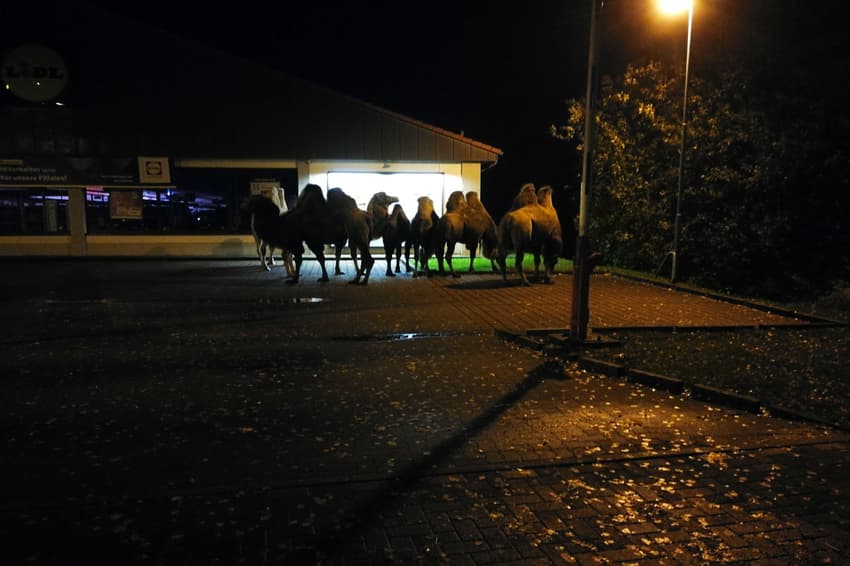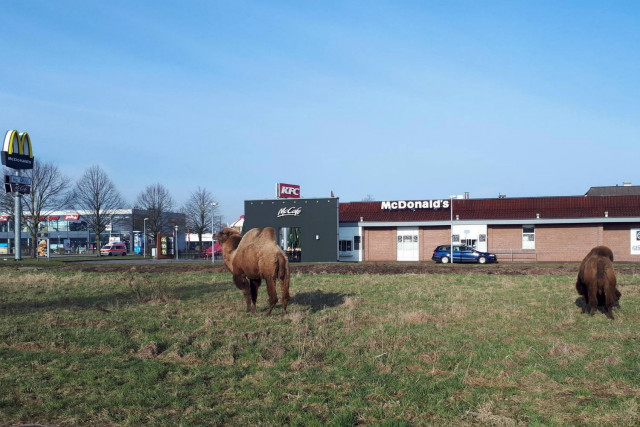Seven camels spotted outside of Lidl in Lower Saxony

Police officers in Bergen, a town in Celle, Lower Saxony, went on an unexpected mission when they received several calls about camels loitering in a shopping mall car park.
The camels had ventured to the parking lot in front of the supermarket Lidl - situated just off of the A3 highway - on Monday night, police reported on Tuesday.
When the officers arrived at the scene at 11:30 p.m., they learned that the animals had escaped from a nearby winter camp of a circus.
"We haven't had runaway camels in our jurisdiction yet," Celle police spokesman Thorsten Wallheinke told The Local. "An employee of the circus had not closed the gate properly, so that the animals were able to run away."
The area was safety secured during the half hour long police operation until the camels were brought back to the circus, and an employee led the animals safely back to their stables.
#Polizei_CE Sie warteten auf die besten Angebote!!! Sieben Kamele standen vor einem Discounter in Bergen! Mittlerweile sind die ausgebüchsten Zirkustiere wieder eingefangen und ins Winterlager zurückgebracht. / b.i.https://t.co/Wl7DvYrPNq pic.twitter.com/JJISMCALNf
— Polizei Celle (@Polizei_CE) November 13, 2018
Their escape marked the second time this year that camels have broken out of a circus. In Bremen in northern Germany, the lead circus camel “Ivan the Great” and another camel were spotted having a vegetarian-friendly feast in the meadow opposite a McDonald’s in April.
After police were called, the two camels were also safely returned to their enclosures.

"Ivan the Great" in Bremen. Photo: DPA
In 2014, Munich police were also called when a concerned resident spotted a pack of seven camels eating plants on their lawn. They had also escaped from a local circus.
While camels are associated with desert climates, they have a long history in Europe, stretching back to the Romans who would use them as working animals.
Nowadays throughout Europe, there are several camel farms selling products such as milk and wool, as well as circuses which feature them.
There are also a number of camel species, from those adapted to warm climates to Bactrian camels native to Central Asia and thus accustomed to colder climates.
Comments
See Also
The camels had ventured to the parking lot in front of the supermarket Lidl - situated just off of the A3 highway - on Monday night, police reported on Tuesday.
When the officers arrived at the scene at 11:30 p.m., they learned that the animals had escaped from a nearby winter camp of a circus.
"We haven't had runaway camels in our jurisdiction yet," Celle police spokesman Thorsten Wallheinke told The Local. "An employee of the circus had not closed the gate properly, so that the animals were able to run away."
The area was safety secured during the half hour long police operation until the camels were brought back to the circus, and an employee led the animals safely back to their stables.
#Polizei_CE Sie warteten auf die besten Angebote!!! Sieben Kamele standen vor einem Discounter in Bergen! Mittlerweile sind die ausgebüchsten Zirkustiere wieder eingefangen und ins Winterlager zurückgebracht. / b.i.https://t.co/Wl7DvYrPNq pic.twitter.com/JJISMCALNf
— Polizei Celle (@Polizei_CE) November 13, 2018
Their escape marked the second time this year that camels have broken out of a circus. In Bremen in northern Germany, the lead circus camel “Ivan the Great” and another camel were spotted having a vegetarian-friendly feast in the meadow opposite a McDonald’s in April.
After police were called, the two camels were also safely returned to their enclosures.

"Ivan the Great" in Bremen. Photo: DPA
In 2014, Munich police were also called when a concerned resident spotted a pack of seven camels eating plants on their lawn. They had also escaped from a local circus.
While camels are associated with desert climates, they have a long history in Europe, stretching back to the Romans who would use them as working animals.
Nowadays throughout Europe, there are several camel farms selling products such as milk and wool, as well as circuses which feature them.
There are also a number of camel species, from those adapted to warm climates to Bactrian camels native to Central Asia and thus accustomed to colder climates.
Join the conversation in our comments section below. Share your own views and experience and if you have a question or suggestion for our journalists then email us at [email protected].
Please keep comments civil, constructive and on topic – and make sure to read our terms of use before getting involved.
Please log in here to leave a comment.